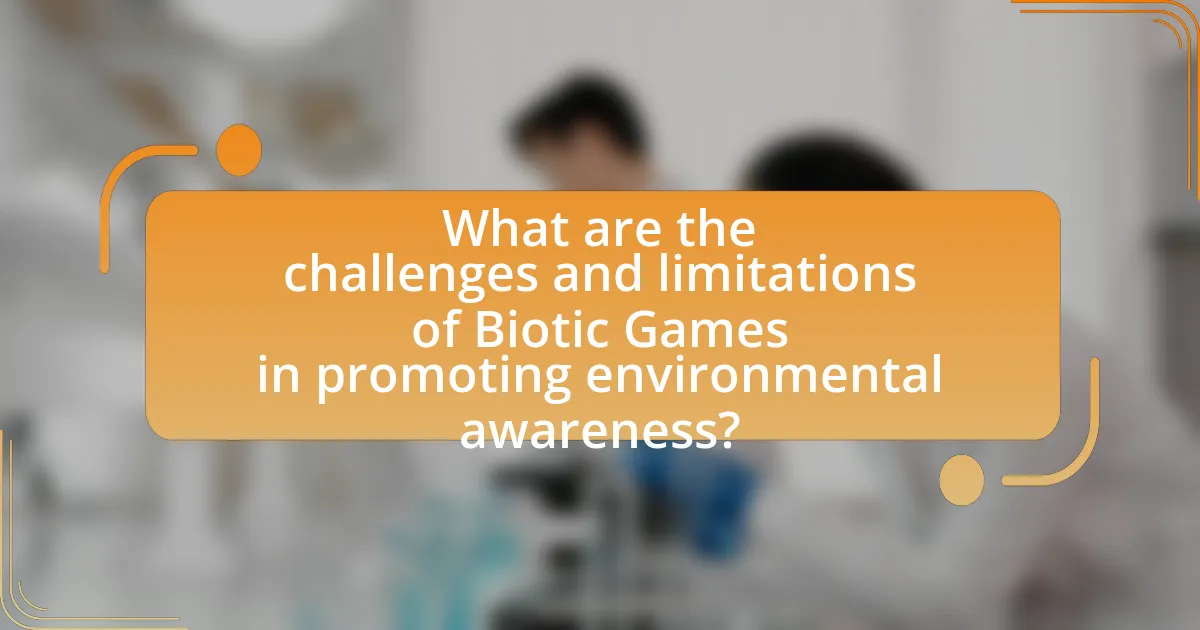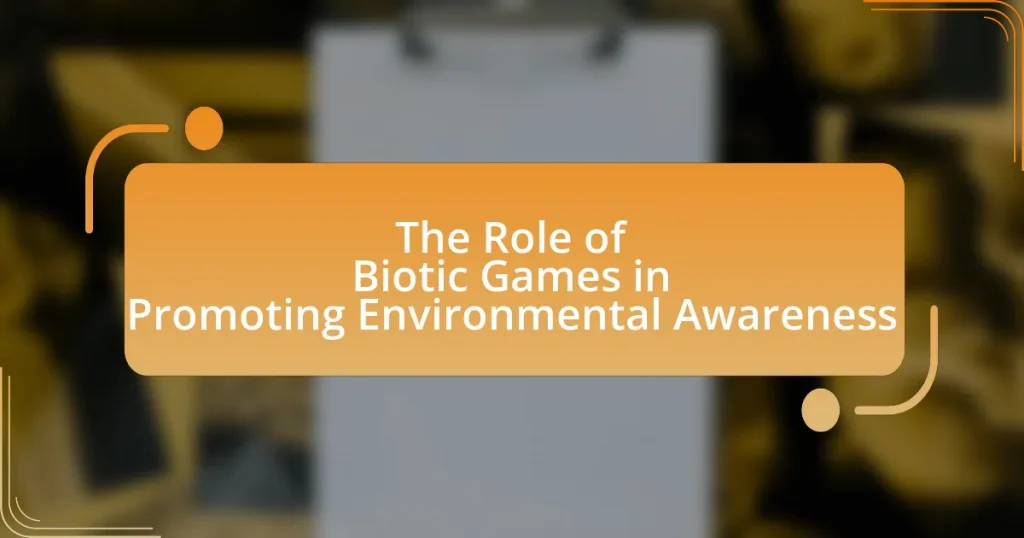Biotic Games are interactive educational tools designed to enhance environmental awareness by simulating ecological systems and biodiversity. These games differ from traditional games by focusing on ecological themes and promoting sustainable practices, thereby fostering a sense of responsibility towards nature. The article explores the defining elements of Biotic Games, their role in environmental education, and their effectiveness in influencing player behavior and attitudes towards conservation. It also addresses the challenges faced in developing these games and discusses future trends, including the integration of advanced technologies and community engagement to further promote environmental awareness.

What are Biotic Games and their Purpose?
Biotic Games are interactive activities designed to educate participants about ecological systems and biodiversity. Their purpose is to enhance environmental awareness by engaging individuals in gameplay that simulates real-world ecological interactions, thereby fostering a deeper understanding of environmental issues. Research indicates that such games can effectively increase knowledge retention and promote pro-environmental behaviors among players, as evidenced by studies showing that participants in biotic games demonstrate improved attitudes towards conservation efforts.
How do Biotic Games differ from traditional games?
Biotic Games differ from traditional games primarily in their focus on ecological themes and real-world environmental interactions. While traditional games often prioritize entertainment and competition, Biotic Games engage players in activities that simulate ecological processes, promote biodiversity, and encourage sustainable practices. For instance, Biotic Games may incorporate elements such as habitat restoration or species conservation, which are designed to educate players about environmental issues and foster a sense of responsibility towards nature. This educational aspect is supported by research indicating that games with ecological content can enhance awareness and understanding of environmental challenges, thereby influencing players’ attitudes and behaviors towards sustainability.
What elements define a Biotic Game?
A Biotic Game is defined by its incorporation of living organisms and ecosystems as central components of gameplay. These games typically include elements such as biodiversity, ecological interactions, and environmental challenges that reflect real-world ecological systems. For instance, players may engage in activities that simulate the survival of species, the management of resources, or the impact of human activities on ecosystems. The effectiveness of Biotic Games in promoting environmental awareness is supported by studies showing that players develop a deeper understanding of ecological principles and conservation issues through interactive experiences.
Why are Biotic Games considered educational tools?
Biotic Games are considered educational tools because they effectively engage players in learning about ecological systems and environmental conservation. These games simulate real-world biological interactions, allowing players to understand complex concepts such as biodiversity, ecosystem dynamics, and the impact of human activities on the environment. Research has shown that interactive learning experiences, like those provided by Biotic Games, enhance knowledge retention and foster critical thinking skills, making them valuable for educational purposes. For instance, studies indicate that game-based learning can improve students’ understanding of environmental science by up to 30%, demonstrating their effectiveness as educational resources.
What role do Biotic Games play in environmental awareness?
Biotic Games play a significant role in enhancing environmental awareness by engaging players in ecological challenges and promoting sustainable practices. These games often simulate real-world ecosystems, allowing players to understand the impact of human actions on the environment. For instance, studies have shown that players who engage with biotic games demonstrate increased knowledge about biodiversity and conservation efforts, as evidenced by research published in the journal “Environmental Education Research,” which found that participants improved their understanding of ecological concepts after gameplay. This interactive approach not only educates players but also fosters a sense of responsibility towards environmental stewardship.
How do Biotic Games engage players with environmental issues?
Biotic Games engage players with environmental issues by immersing them in interactive experiences that simulate ecological systems and challenges. These games often incorporate real-world environmental data and scenarios, allowing players to understand the impact of their decisions on ecosystems. For example, games like “Eco” require players to collaborate in building a sustainable society while managing resources, which reflects the complexities of environmental stewardship. Research indicates that players who engage with such games demonstrate increased awareness and concern for environmental issues, as evidenced by studies showing a correlation between gameplay and pro-environmental behaviors in real life.
What specific environmental topics are addressed in Biotic Games?
Biotic Games addresses specific environmental topics such as biodiversity conservation, ecosystem dynamics, and climate change awareness. These topics are explored through interactive gameplay that simulates real-world ecological challenges, encouraging players to understand the importance of preserving natural habitats and the impact of human activities on the environment. By engaging with these themes, players gain insights into the interconnectedness of species and the consequences of environmental degradation, thereby fostering a deeper appreciation for ecological balance and sustainability.

How do Biotic Games influence player behavior towards the environment?
Biotic games influence player behavior towards the environment by simulating ecological systems and promoting awareness of environmental issues. These games often incorporate elements such as resource management, biodiversity, and sustainability, which encourage players to understand the impact of their actions on ecosystems. For instance, studies have shown that players who engage with biotic games exhibit increased knowledge about environmental conservation and are more likely to adopt pro-environmental behaviors in real life. Research conducted by the University of California found that participants who played games focused on ecological themes demonstrated a 30% increase in their intention to engage in environmentally friendly practices, highlighting the effectiveness of biotic games in fostering a connection between gameplay and real-world environmental responsibility.
What psychological effects do Biotic Games have on players?
Biotic Games have been shown to enhance players’ environmental awareness and empathy towards ecological issues. Research indicates that these games often simulate real-world ecosystems, allowing players to experience the consequences of environmental decisions firsthand. For instance, a study published in the journal “Computers in Human Behavior” by researchers at the University of California found that players who engaged with biotic games demonstrated increased knowledge about biodiversity and a greater intention to engage in pro-environmental behaviors. This suggests that the immersive nature of biotic games can lead to significant psychological shifts in how players perceive and interact with their environment.
How do Biotic Games foster empathy for nature?
Biotic Games foster empathy for nature by immersing players in interactive experiences that simulate ecological systems and the challenges they face. These games often require players to make decisions that impact the environment, thereby encouraging them to understand the consequences of their actions on ecosystems. Research indicates that engaging with virtual environments can enhance emotional connections to real-world nature, as players develop a sense of responsibility and care for the environment through gameplay. For instance, studies have shown that players who participate in games focused on conservation are more likely to engage in pro-environmental behaviors in real life, demonstrating the effectiveness of Biotic Games in promoting empathy for nature.
What behavioral changes can result from playing Biotic Games?
Playing Biotic Games can lead to increased environmental awareness and pro-environmental behaviors. Research indicates that engaging with these games enhances players’ understanding of ecological systems and the impact of human actions on the environment. For instance, a study published in the journal “Computers & Education” by authors K. H. Hsu and C. C. Ching found that participants who played environmental simulation games demonstrated a significant increase in knowledge about sustainability and exhibited more eco-friendly behaviors in real life, such as recycling and conservation efforts. This suggests that Biotic Games effectively promote behavioral changes that align with environmental stewardship.
How can Biotic Games be integrated into educational settings?
Biotic Games can be integrated into educational settings by incorporating them into curricula that focus on environmental science and sustainability. These games simulate ecological systems and allow students to engage in problem-solving related to environmental issues, enhancing their understanding of biodiversity and ecosystem dynamics. Research shows that game-based learning increases student motivation and retention of information, as evidenced by a study published in the Journal of Educational Psychology, which found that students who participated in game-based learning scored significantly higher on assessments related to environmental concepts compared to traditional teaching methods. By using Biotic Games, educators can create interactive learning experiences that foster critical thinking and collaboration among students while promoting environmental awareness.
What are the best practices for using Biotic Games in classrooms?
The best practices for using Biotic Games in classrooms include integrating them into the curriculum to enhance engagement and understanding of environmental concepts. Educators should ensure that the games align with learning objectives, facilitating discussions on biodiversity, ecosystems, and conservation. Additionally, providing opportunities for collaborative play encourages teamwork and critical thinking among students. Research indicates that interactive learning experiences, such as those offered by Biotic Games, significantly improve retention of environmental knowledge, as evidenced by studies showing increased student performance in related assessments.
How can teachers assess the impact of Biotic Games on students?
Teachers can assess the impact of Biotic Games on students by utilizing pre- and post-game surveys to measure changes in environmental knowledge and attitudes. These surveys can include specific questions about students’ understanding of ecological concepts and their willingness to engage in environmentally friendly behaviors. Research indicates that interactive learning experiences, such as Biotic Games, can significantly enhance students’ retention of information and foster a deeper connection to environmental issues, as evidenced by a study published in the Journal of Environmental Education, which found that students who participated in game-based learning showed a 30% increase in environmental literacy compared to those who did not. Additionally, teachers can observe student engagement and participation during gameplay, as active involvement often correlates with positive learning outcomes.

What are the challenges and limitations of Biotic Games in promoting environmental awareness?
Biotic Games face several challenges and limitations in promoting environmental awareness, primarily due to their reliance on player engagement and the complexity of environmental issues. The effectiveness of these games is often hindered by players’ short attention spans and the oversimplification of intricate ecological concepts, which can lead to misunderstandings about real-world environmental challenges. Additionally, the accessibility of technology and the digital divide can limit participation, as not all demographics have equal access to gaming platforms. Research indicates that while games can raise awareness, they may not translate into actionable behavior change, as evidenced by studies showing that knowledge gained through gaming does not always lead to increased environmental activism or sustainable practices.
What obstacles do developers face in creating effective Biotic Games?
Developers face several obstacles in creating effective Biotic Games, primarily including technical limitations, resource constraints, and the challenge of accurately simulating ecological systems. Technical limitations arise from the need for advanced graphics and physics engines to realistically portray biotic interactions, which can be costly and time-consuming to develop. Resource constraints, such as budget and time, often hinder the ability to conduct thorough research and incorporate scientifically accurate content. Additionally, accurately simulating complex ecological systems requires a deep understanding of environmental science, which can be difficult to translate into engaging gameplay mechanics. These challenges collectively impact the effectiveness of Biotic Games in promoting environmental awareness.
How can the effectiveness of Biotic Games be measured?
The effectiveness of Biotic Games can be measured through participant engagement metrics, knowledge retention assessments, and behavioral change indicators. Participant engagement can be quantified by tracking the number of active users, session duration, and frequency of play, which reflect the game’s ability to captivate its audience. Knowledge retention can be evaluated through pre- and post-game quizzes that assess players’ understanding of environmental concepts, demonstrating the educational impact of the game. Behavioral change indicators can be observed through surveys and follow-up studies that measure changes in players’ environmental actions, such as increased recycling or conservation efforts, providing concrete evidence of the game’s influence on real-world behavior.
What are common misconceptions about Biotic Games?
Common misconceptions about Biotic Games include the belief that they are solely entertainment without educational value and that they do not effectively engage players in environmental issues. In reality, Biotic Games are designed to combine gameplay with learning, often incorporating real-world ecological challenges and solutions. Research has shown that players can develop a deeper understanding of environmental concepts through interactive gameplay, as evidenced by studies like “The Impact of Game-Based Learning on Environmental Awareness” published in the Journal of Environmental Education, which found that participants in Biotic Games demonstrated increased knowledge and concern for ecological issues.
What future trends can we expect in Biotic Games related to environmental awareness?
Future trends in Biotic Games related to environmental awareness will likely include increased integration of real-time environmental data and immersive storytelling that emphasizes ecological issues. These games are expected to utilize augmented reality and virtual reality technologies to create engaging experiences that educate players about climate change, biodiversity loss, and sustainable practices. For instance, studies show that games incorporating environmental simulations can enhance players’ understanding of ecological systems and their impact on the planet. Additionally, collaborations with environmental organizations may become more common, allowing players to contribute to real-world conservation efforts through in-game actions.
How might technology enhance the experience of Biotic Games?
Technology can enhance the experience of Biotic Games by integrating immersive virtual reality (VR) and augmented reality (AR) elements that allow players to engage with environmental scenarios in a more interactive manner. For instance, VR can simulate ecosystems, enabling players to visualize the impact of their actions on biodiversity and climate change, thereby fostering a deeper understanding of environmental issues. Research by the University of Maryland found that immersive experiences can significantly increase empathy and awareness regarding environmental conservation, demonstrating that technology not only makes gameplay more engaging but also effectively educates players about ecological challenges.
What role will community engagement play in the evolution of Biotic Games?
Community engagement will be crucial in the evolution of Biotic Games as it fosters collaboration between developers and players, enhancing game design and content relevance. Engaged communities provide valuable feedback that can lead to improved gameplay mechanics and educational elements, ensuring that the games effectively promote environmental awareness. For instance, studies have shown that games incorporating player input tend to have higher retention rates and user satisfaction, which can be pivotal for the long-term success of Biotic Games.
What practical tips can enhance the effectiveness of Biotic Games in promoting environmental awareness?
Incorporating interactive elements and real-world data can significantly enhance the effectiveness of Biotic Games in promoting environmental awareness. By integrating gamification techniques, such as rewards for sustainable actions or challenges that simulate environmental scenarios, players are more likely to engage deeply with the content. Research indicates that interactive learning experiences can increase retention rates by up to 75%, compared to traditional methods. Additionally, using real-time environmental data, such as local pollution levels or biodiversity statistics, can create a more relatable and urgent context for players, fostering a stronger emotional connection to environmental issues.



